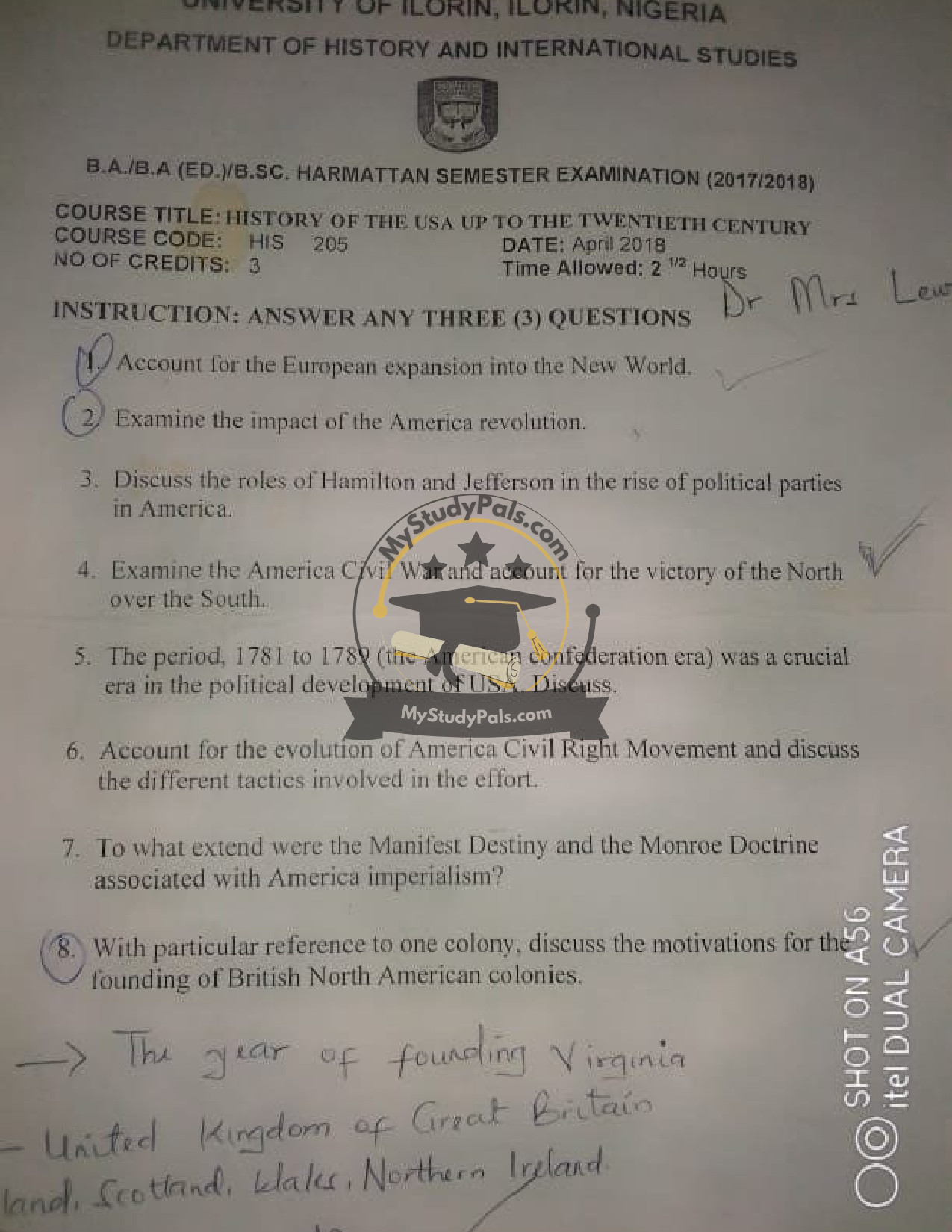ANWSER
—
Question 1: Account for the European expansion into the New World.
Answer:
European expansion into the New World was driven by several factors:
1. Economic Motives: The desire for wealth, particularly through the acquisition of gold, silver, and other resources, fueled exploration. The search for new trade routes to Asia (e.g., the Spice Trade) also played a significant role.
2. Religious Zeal: Missionary efforts to spread Christianity, especially by Spain and Portugal, led to colonization.
3. Political Competition: European powers (e.g., Spain, England, France) sought to expand their empires and outrival one another.
4. Technological Advancements: Innovations in navigation (e.g., the compass, astrolabe) and shipbuilding (e.g., caravels) made long voyages feasible.
5. Social Factors: Overpopulation, poverty, and the promise of land ownership encouraged migration to the Americas.
—
Question 2: Examine the impact of the American Revolution.
Answer:
The American Revolution (1775–1783) had profound effects:
1. Political Independence: The Thirteen Colonies broke free from British rule, leading to the creation of the United States of America.
2. Inspiration for Global Revolutions: It inspired later movements, such as the French Revolution (1789) and Latin American independence struggles.
3. Democratic Ideals: The Revolution promoted Enlightenment principles like republicanism, individual rights, and popular sovereignty, reflected in documents like the Declaration of Independence (1776) and the U.S. Constitution (1787).
4. Economic Changes: Mercantilist policies were replaced by free trade aspirations, though economic instability followed post-war.
5. Social Shifts: While slavery persisted, the Revolution sparked debates about equality and liberty, leading to gradual emancipation in Northern states.
—
Question 3: Discuss the roles of Hamilton and Jefferson in the rise of political parties in America.
Answer:
Alexander Hamilton and Thomas Jefferson were pivotal in shaping America’s first political parties due to their opposing visions:
1. Hamilton (Federalist Party):
– Advocated for a strong central government, a national bank, and industrialization.
– Supported close ties with Britain and elite governance.
2. Jefferson (Democratic-Republican Party):
– Championed states’ rights, agrarian democracy, and strict constitutional interpretation.
– Favored France and distrusted centralized power.
Their ideological clashes over fiscal policy (e.g., debt assumption), foreign alliances, and federal authority crystallized the two-party system by the 1790s.
—
Question 4: Examine the American Civil War and account for the victory of the North over the South.
Answer:
The American Civil War (1861–1865) resulted in Northern victory due to:
1. Industrial Superiority: The North had more factories, railroads, and resources to sustain prolonged war.
2. Population Advantage: Larger manpower pools allowed for greater troop numbers and replacements.
3. Naval Blockade: The Union’s Anaconda Plan crippled Southern trade and supplies.
4. Leadership: Lincoln’s strategic leadership and generals like Grant outmatched Confederate tactics.
5. Economic Weakness: The South’s reliance on cash crops (cotton) and slavery left it vulnerable to supply shortages and diplomatic isolation.
—
Question 5: The period, 1781 to 1789 (the American confederation era) was a crucial era in the political development of the USA. Discuss.
Answer:
The Confederation Era (1781–1789) under the Articles of Confederation was critical because:
1. Weak Central Government: The Articles created a loose alliance of states with no taxing power or executive branch, exposing governance flaws.
2. Economic Chaos: Debt, inflation, and interstate trade disputes (e.g., Shays’ Rebellion) highlighted the need for reform.
3. Constitutional Convention (1787): These failures led to the drafting of the U.S. Constitution, establishing a stronger federal system with checks and balances.
4. Foundational Debates: Issues like state sovereignty vs. federal authority were resolved, shaping the nation’s political framework.
—
Question 6: Account for the evolution of the American Civil Rights Movement and discuss the different tactics involved in the effort.
Answer:
The Civil Rights Movement evolved through:
1. Early Efforts (Pre-1950s): Organizations like the NAACP fought legal battles (e.g., *Brown v. Board*, 1954).
2. Nonviolent Protests (1950s–60s):
– Boycotts (Montgomery Bus Boycott, 1955).
– Sit-ins (Greensboro, 1960) and Freedom Rides (1961).
– Marches (Selma to Montgomery, 1965).
3. Legislative Milestones: The Civil Rights Act (1964) and Voting Rights Act (1965) were achieved through lobbying and public pressure.
4. Radical Tactics (Late 1960s): Groups like the Black Panthers advocated armed self-defense amid frustration with slow progress.
—
Question 7: To what extent were the Manifest Destiny and the Monroe Doctrine associated with American imperialism?
Answer:
Both concepts fueled U.S. imperialism but differed in scope:
1. Manifest Destiny (1840s): Justified westward expansion (e.g., Mexican-American War, annexation of Texas) as a divine right to spread democracy and capitalism.
2. Monroe Doctrine (1823): Declared European interference in the Americas unacceptable, later used to justify U.S. dominance (e.g., interventions in Latin America).
While Manifest Destiny focused on continental expansion, the Monroe Doctrine extended U.S. influence hemispherically, both serving imperialistic goals.
—
Question 8: With particular reference to one colony, discuss the motivations for the founding of British North American colonies.
Answer:
Virginia (founded 1607):
1. Economic Gain: The Virginia Company sought profit through tobacco cultivation.
2. Land Ownership: Colonists desired private land, unlike England’s feudal system.
3. Religious Freedom: While initially profit-driven, later settlers included Anglicans and dissenters.
4. Strategic Expansion: England aimed to rival Spanish colonies and secure raw materials.
—


